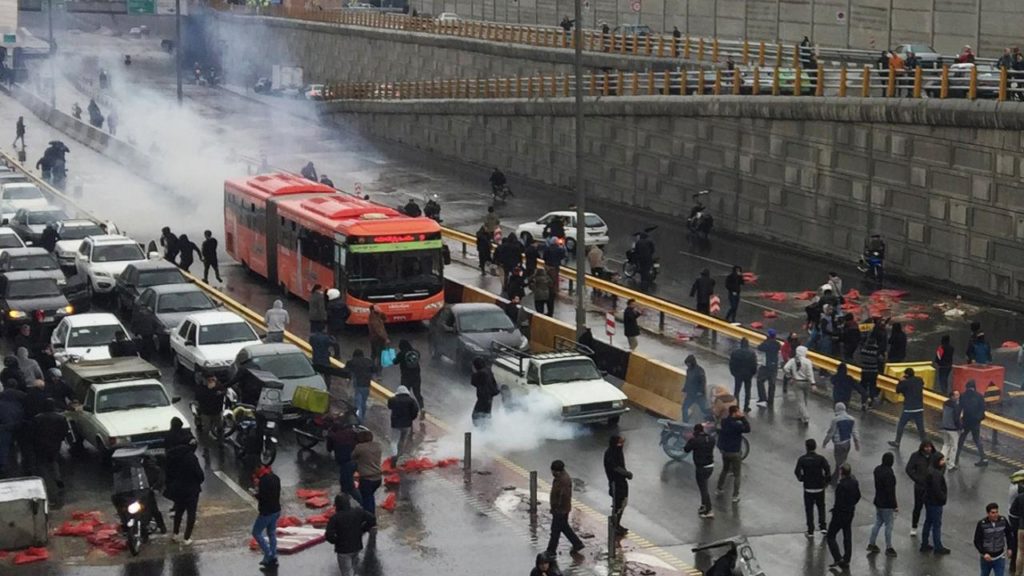Faced with crippling international sanctions, revenue shortfalls and budget deficits, the Islamic regime in Iran seems to have made a fatal miscalculation by suddenly tripling the price of gasoline, a move which appears to put an entire region in flames.
Frustrated by worsening economic conditions, soaring prices and devastating national currency devaluation, Iranians from across the country immediately took the streets to demand a reversal of the decision. But what seemed to have started as a peaceful civil demonstration - in where drivers turned off their vehicles in the middle roads and highways - quickly escalated to a full-fledged uprising in nearly 100 cities. But not just in Iran. In Iraq, protesters burned the Iranian consulate in the holy city of Najaf and in Lebanon hundreds of thousands of people have taken to the streets, demanding the resignation of a government dominated by pro-Iran factions.
Shocked by the scope of the Iranian people’s response, Islamic regime’s parliament held an emergency session. In a televised speech, Iran’s supreme Leader Khamenai tried to somewhat distance himself from the decision and President Rouhani tried to calm the people by saying that his government’s goal is to help the middle and lower income class and that the revenues will be redistributed amongst the poor.
Unimpressed with these Robin Hood gestures, the streets remained unfettered. In Karaj, Isfahan, shiraz, Tehran and Kurdish cities of Kermanshah, Sanandaj, Baneh and Marivan as well as cities like Ahwaz, Shadegan, Behbahan and others in the oil producing Khuzestan province, over 400 people have already been shot to death. Yet the demonstrations have not subsided. On the contrary, the gas protests seems to have ignited a full-fledged uprising against the Islamic regime.
The street had echoed its own message to the world and to the Islamic regime with flags set on fire next to the supreme leader’s banners. “We do not wish to die for Hezballah or for Hamas, we wish to live for Iran” ; “the revenues have gone missing; it’s been spent on Palestine,” reminding people that enormous resources were spent in foreign adventures.” “Death to the dictator” and “Reza Pahlevi, God bless your soul” were also amongst the most popular slogans, reminding the regime that the people continue to embrace their arch enemy, symbolizing everything the Islamic revolution is not.
Yet again – as in previous waves of protests, the Iranian people are marching for change.
What might be new in this round – and unlike previous waves of protest – is that they don’t march alone. Lebanon and Iraq whiteness a similar wave of demonstrations, demanding an end to Islamic regime’s destructive interferences in their countries. In Lebanon, where Iran continued it’s support of Hezballah – a militia that became stronger than the Lebanese army and part of the Lebanese government – people have marched calling for an end to an agenda that again prioritizes foreign interventions to that of the people of Lebanon. In Iraq – where Iran continue to support Shi’a faction and proxies – tens of thousands have asked for the same thing: “live for Iraq, not to die for Iran.” However, over 400 Iraqis already lost their lives for that call.
Incapable of coming up with a solutions, Iran’s supreme leader pointed to what he calls “the enemies” plots – an accusation which gives ‘license to kill’ of those “enemies of the revolution.” The head of the Kuds force, General Qasem Soleimani, was sent to Najaf for that very purpose.
The second wave of the Arab spring appears to be ignited. Again, millions are taking the streets demanding a change. However, there is something different here that may worth a notice. What appears common to most of those marching in Iraq, Iran and Lebanon is a demand to get their countries back. It is Iran which have turned Syria, Lebanon and Iraq into a proxy arena that collapsed not only the countries in question but also Iran itself. It is their countries that the street seeks again to pursue. Lebanon for Lebanese, Iraq for Iraqis and Iran for Iranians. The Islamic regime is their common address.
The International community - particularly the European – should notice and join that call. The Islamic regime may again seek to shut the streets by shooting – a method commonly used by it’s proxies in Iraq, Syria, Lebanon and Gaza. But if stopping another wave of violence and terror in the region is at all a priority, the international community should do more to support those who march and help them get their countries back. The fuel of the revolution is ignited. It must not be quenched.
By Dr. Nir Boms and Shayan Arya

